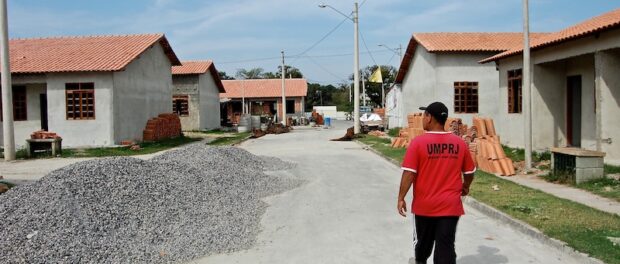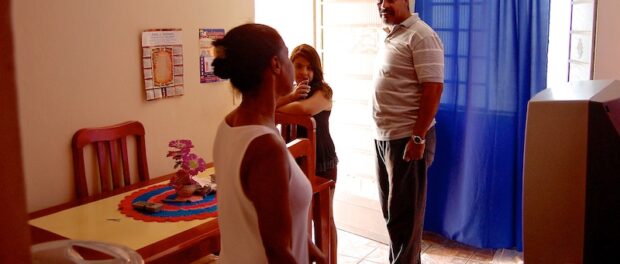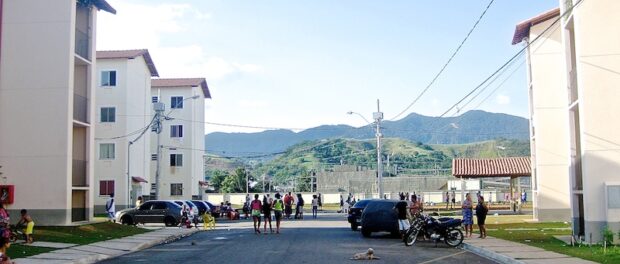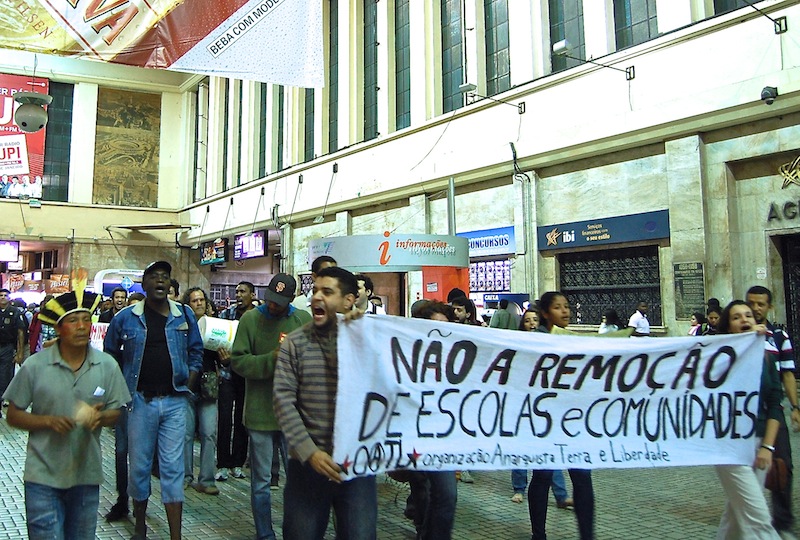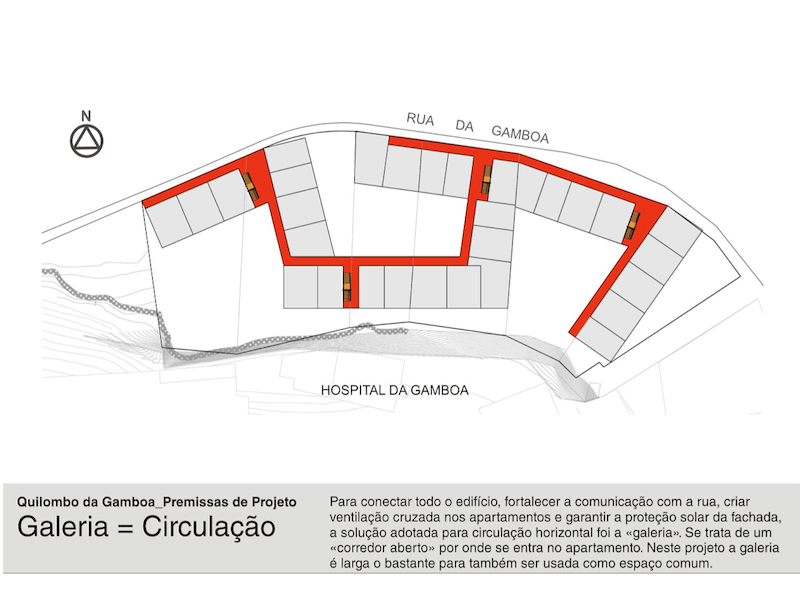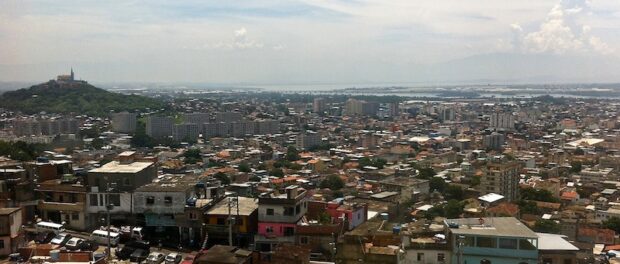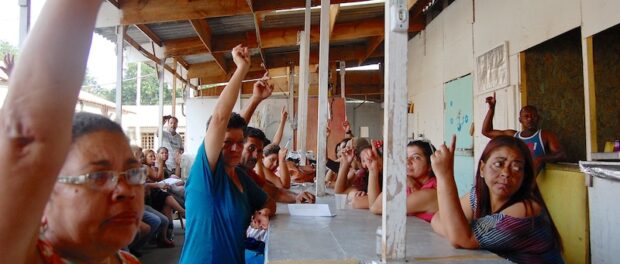Every month, representatives of 116 families meet in a warehouse in central Rio. The families currently live in different parts of the city: in the favelas of Parque da Cidade and Providência, the urban occupation Quilombo das Guerreiras, and other parts of Rio’s downtown and Port Zone. Because of their involvement with the social movements Central de Movimentos Populares (Center for Popular Movements, or CMP) and União Nacional por Moradia Popular (National Union for Popular Housing, or UMP), and thanks to financing from the federal program Minha Casa Minha Vida-Entidades, they will soon all live together in an apartment building on the site of the warehouse and five adjacent lots.
The project is called Quilombo da Gamboa, and it will provide government subsidized affordable housing for families making up to three times the Brazilian minimum wage, or under R$1,600 (US$695) per month. Because it’s in Rio’s central Port Zone, residents will enjoy access to the jobs and other urban resources that brought many of them to their current homes in Rio’s South or Central zones. The design has two interior courtyards to cultivate community life, and one that will have access to the street so that residents are connected with the outside neighborhood. The architecture firm talked through these design decisions with the entire group, just as the group decides together about maintenance of the current lots and music and holiday events they currently organize.
Josilene Lima, a 38-year-old domestic worker, first attended an organizing meeting for the Quilombo da Gamboa because a friend thought she might find it interesting. Curious about the group’s organizational style, she asked a question about it at the meeting, and was drawn in by the enthusiasm and participatory nature of the group. Lima is now one of Gamboa’s coordinators and a regional representative of the UMP, and she speaks gratefully of the hope and friendships she’s found in the process, even through struggle: “No one is born knowing things. I’m here where I never thought I would be because I’ve gotten attached to a group of people who work for something better.”
Across the city in the West Zone neighborhood of Colônia Juliano Moreira, another housing cooperative called Grupo Esperança is in progress with a slightly different setup: with an architect’s support, the families themselves are building seventy single-family brick homes. Under a fluttering yellow UMP flag, they meet every Sunday for a group workday, traveling from areas such Campo Grande, two hours farther west, and Vigário Geral, two hours to the north.
Grupo Esperança too is designed with participatory management at every step. Over a lunch cooked and served by two co-op members, the group votes on their budget for the coming weeks and any necessary decisions about hiring and booking for construction shifts.
In both Quilombo da Gamboa and Grupo Esperança, residents will become owners of their homes under a collective contract. The co-ops are subsidized by a federal program called Minha Casa Minha Vida-Entidades, which supports self-organized affordable housing intiatives that are affiliated with non-governmental organizations. These and other Rio co-ops are possible due to a great deal of technical, legal, and organizational support from the Bento Rubião Human Rights Foundation and from social movements for the right to housing.
The co-ops are in demand. Jurema Constâncio is helping coordinate Grupo Esperança after a successful ten years of living in the co-op of Shangri-La in nearby Taquara. Esperança architect Alexandre Correira stops in to visit families in the Herbert de Souza co-op, which he also designed, on the way to visit his current site. And Joseline Lima has enough people on the Quilombo da Gamboa waiting list to fill several future collectives.
The Face of Affordable Housing in Rio
The housing deficit in the city of Rio was calculated by the Pereira Passos Institute in 2011 as 148,000 units. This includes homes that are needed for people in precarious housing, those who live multiple families to a home, families that earn up to three times the minimum wage and spend more than 30% of their income on rent, and homes with more than three people per bedroom. Under federal law, people who make up to ten times the minimum wage and are not homeowners qualify for subsidized “social interest” housing; those in the greatest need make up to three times the minimum wage and are classified as “strip one” income earners.
The people that public housing is designed to serve are found across the city, and many who fall into this category live in Rio’s favelas, which house a range of lower income-earners and various levels of quality of housing, from precarious to consolidated. When told they must move to public housing units, however, thousands of families from more precarious favela housing every year choose not to go—and many campaign vigorously to stay where they are. That’s because of the quality and inaccessible location of the standard public housing units, financed through the primary arm of the Minha Casa Minha Vida program. The majority of these units are built in the city’s distant peripheries, where one housing department official warned against creating “ghettos of poverty,” and where paramilitary militia groups frequently extort money and prohibit political behavior from residents.
Bento Rubião Foundation director Ricardo de Gouvêa Corrêa explains that quality issues in the conventional Mina Casa Minha Vida units come from the fact that the developers for the units are contracted by the government, siphon funds by utilizing the poorest quality materials available, take no input from future residents, and that their incentive is to build where land is the cheapest. “Minha Casa Minha Vida was promoted as something that would boost Brazil’s economy through the civil construction sector,” adds Gouvêa. “But what it destroyed was high-quality housing.”
United Nations Rapporteur for the right to Adequate Housing Raquel Rolnik reported to the UN General Assembly in 2012 that the global trend of privatizing government-subsidized housing into the hands of developers motivated by market incentives before the social aspects of housing “has contributed to a widespread bubble in real estate prices and a decrease in affordability and has done little to promote access to affordable adequate housing for the poorest.”
The vast majority of favela residents would rather see on-site infrastructure upgrades to their neighborhoods than move to Minha Casa Minha Vida housing projects. International urbanists and local officials agree—and it has been legislated as such—that on-site upgrades, rather than resettlement, are the best approach to addressing the infrastructure needs of the favelas. But upgrades inch along, and special legal guidelines designed to help ease the transition into formality for favela residents, called Zones of Special Social Interest, are only partially carried out in Rio such that residents see home and utility prices rise dramatically before they benefit from the improvement in services.
The affordable housing option the government continues to bankroll are the Minha Casa Minha Vida apartments. Of the Minha Casa Minha Vida budget, at most 5-10% each year is invested in Entidades co-operatives.
The Brazilian government’s commitment to affordable housing is due in large part to the work of the National Forum for Urban Reform, a coalition of social movements, urbanists, researchers, and human rights advocates that came together during the drafting of Brazil’s post-dictatorship constitution of 1988. They successfully advocated for an article about the social function of property that was followed by specific provisions for housing in cities. The Forum argued that existing urban informality developed from a need for land reform that dates back to the abolition of slavery, when black Brazilians were forbidden from owning property. The rural counterpart working for land reform in Brazil, the Landless Worker’s Movement (MST), is one of the largest social movements in Latin America.
Based on the principle of the social use of property, the Forum and its allies proposed a public fund for low-income Brazilians to purchase and reform homes, buy construction materials, urbanize informal settlements, buy group equipment, and conduct landholding regularization. They drafted the first constitutional bill of popular origin, and after thirteen years of advocating, the National Fund for Social Interest Housing (FNHIS) was created in 2005.
Near R$1 billion per year was set aside for FNHIS, and through programs called “Solidarity Credit” and “Support for the Social Production of Housing,” it began to fund self-managed affordable housing projects in vacant federal and city properties, such as the Rio co-ops Shangri-La, Mariana Criolo, and the early stages of Gamboa and Esperança. But the money and approval for these projects lagged and then decreased dramatically after President Lula announced the Minha Casa Minha Vida program, together with its Entidades offshoot, in 2009. “Today the Fund,” says Ricard Correia, “does not have funds.” Between 2008 and 2011, federal funding contracted 30,000 units of co-op housing and 449,000 units of privately contracted Minha Casa Minha Vida apartments.
Now, around R$1 billion annually is set to go toward the Entidades projects. Marcelo Edmundo of CMP, one of the coordinators of the Quilombo da Gamboa, worries that co-op funding that comes from a presidential program is less stable than a permanent fund that is codified into law. Ricardo Gouvêa says the source of the funding is less worrisome than whether it will actually be released. Although the FHNIS money, for example, was projected at R$4 billion between 2008 and 2011, only 7% of that money was actually used to build projects.
Gouvêa says the bureaucratic barriers to getting funding released for co-op housing projects are still maddening. This year members of the housing social movements were driven to protest in front of the federal bank Caixa Econômica Federal, which is responsible for financing Minha Casa Minha Vida, after it had stalled for years in processing completed paperwork for an Entidades building reform downtown. In 2011 Gouvêa was part of a group that traveled to Brasília and physically blocked Lula’s car to demand bottlenecked funding for another Entidades project. He recently saw eight months of delays simply trying to procure the correct documents for an Entidades environmental license, eventually traveling to the national capital. “The proportion of funding that is released for these projects is just not adequate,” Gouvêa says.
Preserving Affordability
Rio’s favelas, even those receiving upgrades–as well as the city’s public housing–have yet to see committed, legally clear, holistic measures to preserve affordability. In a standard Minha Casa Minha Vida apartment, residents can sell after five to ten years (although scandals of early sales abound across the country). In Quilombo da Gamboa and Grupo Esperança, residents can sell after ten years, although they are encouraged only to do so to others in need of subsidized housing.
When Columbia School of Architecture Dean Mark Wigley called affordable housing “the issue of our time” in a debate with Rio Mayor Eduardo Paes last month, he was referring not only to facilitating affordability but also to sustaining it.
Perhaps the best answer to whether conventional public housing in Rio is successfully addressing the city’s needs is the fact that despite its construction between 2000 and 2010, the city’s favela population grew over 27%, while the population of the rest of the city grew 7.4%. Furthermore, in many public housing units such as City of God, residents who had difficulty accessing urban resources such as jobs built additional brick units for workspace in the streets and adjacent areas to the extent that the community–originally public housing–became considered a “favela.” Residents frequently address the limitations of public housing design in Rio, adapting the built environment to their needs in “favela-style.”
To sustain the affordability of public housing, Marcelo Edmundo would prefer if collective property ownership were legal in Brazil. This is the case in Uruguay, where over 20,000 families are living in homes and apartments built through mutual aid: individual units can only be inherited or sold back to the group. The Uruguaian co-ops were studied, and their designers involved in a policy exchange with Rio architects, social movements, and public officials, during the creation of the Bento Rubião Foundation’s housing assistance program.
Many point out that Brazil’s strong tradition of individual property rights makes collective property ownership difficult to imagine politically. But it is not the only method of preserving housing affordability; Raquel Rolnik included several in her 2013 recommendations to the UN General Assembly. Another is responsible government care of informal rental housing (found in Rio’s favelas). Yet another is rent legislation and rent control. In addition, Rolnik describes in detail various types of housing cooperative systems that include group decision-making but vary in whether units are for rental or ownership, and whether finance support includes loans on materials, loans for individual family needs, and group savings.
Organizing
Whether collective management of public housing projects, as currently exists in Gamboa and Esperança, should be fortified by the passing of collective land ownership in Brazil is an ongoing discussion among right to housing social movements and those who work in urban policy.
On November 21 through 23rd, Brasília hosted the National Conference of Cities, a triennial forum for citizens to debate and propose urban legislation. Committees in cities around the country that have been meeting for months came up with an agenda that recommended the consideration of a constitutional amendment that would allow collective property use, a permanent and robust National Fund for Urban Development that would add to existing FHNIS funds for housing and other social needs, and a national plan for regularizing land ownership that guarantees permanence to families and avoids expulsion by the real estate market.
“I’m almost certain that very little of the proposals will pass,” said Rio de Janeiro Federal University planning professor Orlando Santos Junior, a delegate from Rio, before the conference. The National Fund for Urban Development, for example, was proposed two conferences ago. At this conference, the base text for its foundation was voted in by the group.
Another recommendation Raquel Rolnik made to the United Nations this year was for the removal of bureaucracy in access to affordable housing methods. For example, in the regularization of informal rental markets, “states should…include in their housing programs incentives and subsidies to assist small-scale landlords to expand and improve habitability in rental accommodation,” and “encourage and support the use of standardized rental contracts, in order to reduce the number and severity of disputes between landlords and tenants. To that end, standard forms of contracts should be freely available and widely distributed and should not require notary approval.” This level of ease and clarity is the opposite, in fact, of the current difficulties in regularizing tenure in favelas as well as accessing funding for cooperative housing.
At a recent Quilombo da Gamboa meeting, future resident Aldair Alves gave a rousing speech to inspire his peers to accompany him to a government office downtown to check on the status of funding for construction: “The government is not just going to put things in your lap!” People applauded. “You have to go bang on their door and say, ‘I have a right to this.’”
Across the country, Entidades projects continue to move forward, according to an Observatório das Metropolis study done in São Paulo and Porto Alegre, creating “high-quality housing, self-esteem, social mobilization, and the vision of constructing a new city.” They are a testament to the power of committed neighbors and future neighbors that self-organize to address their needs, a power that, with clear and responsive government treatment, could be multiplied.
See full slideshow from Grupo Esperança:
Created with Admarket’s flickrSLiDR.

